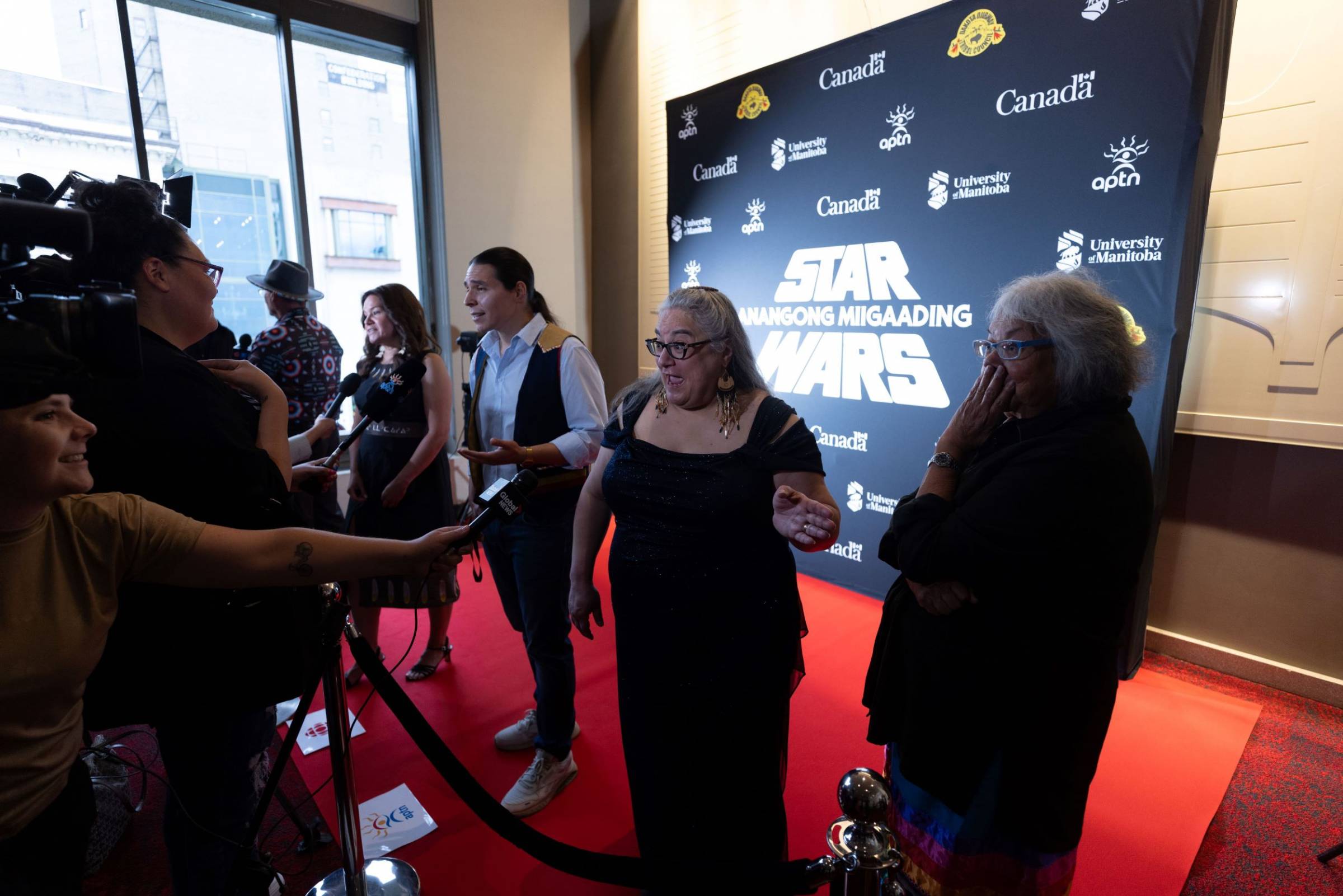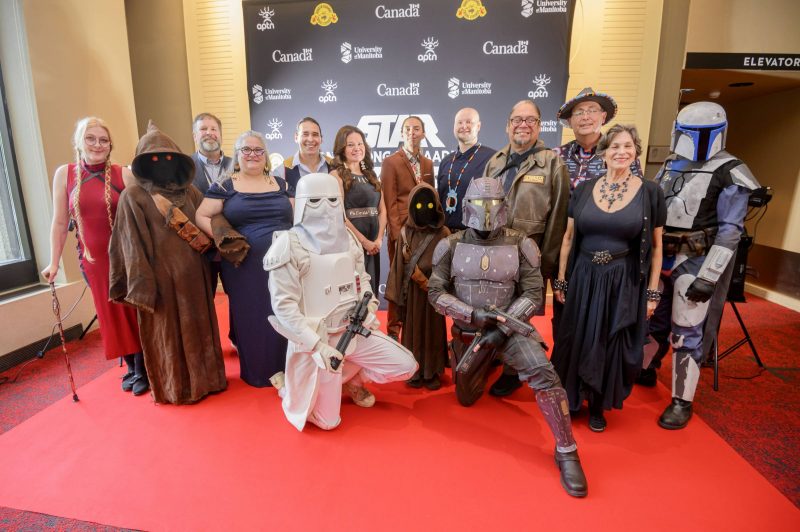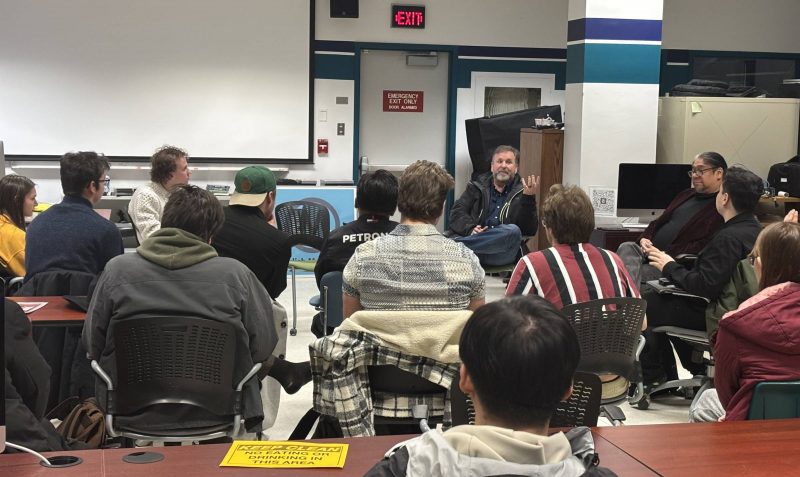
Dr. Cary Miller, Pat Ningewance and Indigenous voice actors interviewed by media at Anishinaabemowin-dubbed Star Wars movie premiere in Winnipeg. Photo by Adam Dolman.
The Force is strong with Anishinaabemowin: Honouring National Indigenous Languages Day
Anishinaabemowin-dubbed Star Wars: A New Hope revitalizes the language for the next generation

“Star Wars (Anangong Miigaading): A New Hope” movie poster.
When Pat Ningewance, assistant professor in the Department of Indigenous Studies, first heard “Star Wars (Anangong Miigaading): A New Hope” in Anishinaabemowin, she couldn’t help but smile. The hum of lightsabers, the beeps of R2-D2 and the clash between good and evil had all stayed the same—but now, they were infused with the voices of her people.
For decades, Ningewance, who was lead translator on the film, has been an advocate for Indigenous language revitalization, teaching, translating and writing to ensure Anishinaabemowin remains strong for future generations. Translating an iconic sci-fi film into Anishinaabemowin? That was a brand-new challenge.
“It was exciting, but also a little nerve-wracking,” she admits. “We had to make sure it felt natural. We had to ask: How would a fluent speaker of Anishinaabemowin say, ‘May the Force be with you’ in a way that carries the same power and meaning?”
Celebrating language revitalization on National Indigenous Languages Day
March 31 is National Indigenous Languages Day, a time to recognize and celebrate the rich linguistic heritage of First Nations, Inuit and Métis peoples in Canada. It is also a time to reflect on the importance of revitalization efforts and the urgent need to preserve Indigenous languages for future generations.
Projects like the Anishinaabemowin “Star Wars” adaptation show how language can thrive when presented in new and engaging ways. By weaving Indigenous languages into pop culture, these efforts ensure that younger generations can see—and hear—their languages in the world around them.
Language is a way to connect with Ancestors

Voice cast, filmmakers, costumed characters and special guests celebrate “Star Wars (Anangong Miigaading), A New Hope” at the world premiere in Winnipeg on August 8, 2024. Photo by Mike Sudoma for Disney.
Dr. Cary Miller, associate professor in Indigenous Studies and the film’s project manager, has long supported Indigenous language revitalization efforts and believes projects like this do more than preserve language—they breathe life into it.
“Language is more than just words,” she says. “It’s how we see the world, how we connect with our ancestors. When we put Anishinaabemowin in a space like “Anangong Miigaading,” we’re showing young people that their language belongs everywhere—not just in textbooks, but in movies, in music, in their everyday lives.”
For many Indigenous youth, hearing their language in “Anangong Miigaading” is more than just cool—it’s transformative. It tells them that their language is alive, relevant and full of possibility.
More than just a film
The Anishinaabemowin “Star Wars: A New Hope” project isn’t just a film translation. It’s recognition that Indigenous languages belong in every space—on the big screen, in pop culture and in the hearts and minds of future generations.
For centuries, Indigenous languages were systematically silenced through colonial acts like residential schools, which aimed to erase them completely. As a result, many Indigenous communities have fought tirelessly to keep their languages alive, with fluent speakers dwindling. This project represents a new frontier in language revitalization, using modern media to reconnect younger generations with their linguistic and cultural heritage.
Indigenous languages thriving

Maeengan Linklater from the Dakota Ojibway Tribal Council and Michael Kohn from Lucasfilm speak to UM Filmmakers Club.
National Indigenous Languages Day serves as a powerful reminder that Indigenous languages are not relics of the past—they are languages of the future. From film translations to language classes, these efforts help reclaim and strengthen these languages for generations to come.
This past February, the Office of the Vice-President (Indigenous) brought this groundbreaking film project to UM’s Fort Garry campus as part of the Indigenous Scholars Speaker Series. They hosted an event featuring a panel discussion with key contributors to the project, including Ningewance and Dr. Miller, as well as project partners Maeengan Linklater from the Dakota Ojibway
Tribal Council and Michael Kohn from Lucasfilm. The discussion was followed by a screening of the Anishinaabemowin-dubbed “Star Wars: A New Hope” and visit to the UM Filmmakers Club.
Panelists shared the story behind this significant project—why it matters, the challenges of translation and how hearing Anishinaabemowin in a blockbuster film can inspire a new generation of speakers. Dr. Miller says these conversations and interactions with students are important and she hopes to continue them in the future.
“Offering panels and screenings provides a chance for students and the broader community to hear, learn from and engage with Indigenous languages in a meaningful way. These events reinforce that our languages are not just surviving—they are thriving!”
As we celebrate Indigenous languages on March 31, it’s a reminder that revitalization is a shared responsibility. Whether through learning, speaking or supporting initiatives that bring these languages into new spaces, we all have a role to play.
You can watch “Anangong Miigaading” any time on Disney+.
“Gi-ga-miinigoowiz Mamaandaawiziwin”—”May the Force be with you.” And may Indigenous languages continue to thrive.






